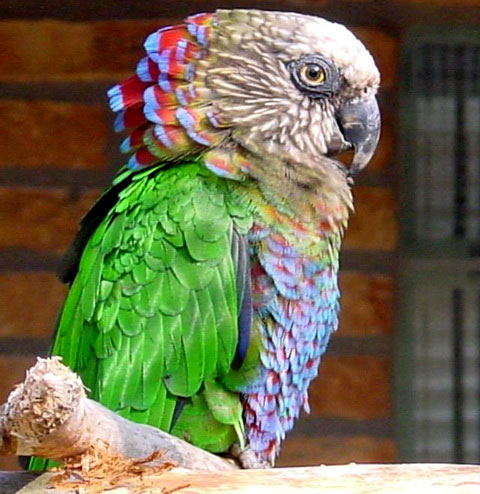
Red-fan parrot, orHawk-headed parrot(Deroptyus accipitrinus)
Phylum —chordata
Class — aves
Order — psittaciformes
Family — psittacidae
Genus— deroptyus
Appearance
The Hawk-headed parrot is approximately the size of an Amazon with the length reaching about 35 cm. However, the feel of the body is slender and the weight is less than that of the Amazon almost making one believe this bird is more fragile when it is not.
The lower part of the face has dark brown feathers interspersed with buff. The color of the crown starts as buff and your attention is drawn immediately to the colorful crown feathers. The crown feathers are very long and can be extended, at will, displaying a circular crown of burgundy feathers tipped in blue. The chest from the neck down to the tail also has the burgundy feathers tipped in blue. The back and the upper sides of the wings and the legs are a dark forest green. The undersides of the wings are forest green at the tips and blend to a dark brown or black going toward the body.
Habitat
It dwells in Ecuador, Suriname, Bolivia, Brazil, Colombia, areas of northeast Peru, Venezuela, French Guiana and Guyana.
Behavior
In the wild the Hawk-headed parrots associate in pairs within a small flock. As a pet in your home, you or members of your family are the other half of the pair. They sleep singly in a tree but close to the flock. They are very social and will become quite attached to their human caretaker, as well as very willing to interact with other people. Their call is either a very soft cooing or talking when in it wants affection or is curled up on your chest or under your neck.
The Hawk-headed parrot is quiet when playing alone in its cage, or with you. At times though, they become very excited or upset and they will make a high-pitched call that can be quite loud. They are having a temper tantrum. This definitely occurs if you eat in front of them without sharing your food or when they feel they should be the boss. The Hawk-headed parrot will make a hissing sound if it is mad or frightened which is believed to be a defensive behavior. It is definitely a sound that most living things would surely back away from.
Diet
Their natural diet consists of fruits, seeds, nuts, flowers,leaves and buds.
Reproduction
The bird nests in holes in trees and stumps. Two to three eggs are normally laid, hatching after approximately 26 days. The young start to fledge in the wild at approximately 10 weeks old.
In captivity
Lifespan of these animal is about 40 years.
Food and water should be available to the Hawk-headed parrot at all times. The water should be kept fresh and changed daily and the bowls should be kept clean. Hawk-heads eat a variety of seeds, nuts, fruits, and commercial pellets, as well as the same nutritional foods humans eat. They do require a higher fat diet, similar to the macaw and they definitely enjoy those nuts and meat. Avocado and chocolate are considered toxic for birds and sugar and salt should be avoided. Human food or prepared foods should be removed from the cage after 4 hours.
These parrots require frequent bathing to keep their feathers healthy and are happy to have a bath in the kitchen sink or the shower. Turn the water on a light spray and they will frequently lay on their backs with their feet straight up displaying the full extent of crown as they bounce up and down on their backs.
A roomy cage is required for the Hawk-heads. This is an active parrot that likes to play and swing upside down from toys expanding its wings and crown at the same time. It is recommended that a cage be 3 feet wide and 2 feet deep.
Hawk-headed parrots can tolerate a wide variety of temperatures from quite cold to very warm. However, they should be kept away from any drafts.They love to be out of their cage to play with their human and will make anything available to them into a toy. The favorite place to perch is the top of your head and they are quite demanding in their desire to join you for meals.
A variety of perches should be used of varying size and texture. A rougher texture rather than smooth makes it easier for them to perch and is better for their feet and legs. A concrete perch can be placed as the highest perch in the cage and next to a toy. At times during the day they will perch there and it will save them (and you) from the ordeal of having their nails filed.
They love a little cubbyhole to sleep in and will definitely make use of the furry bird beds that are available. They are more secure with the back of the cage (and their bed) against or close to a wall or in a corner of the room given there is light. These parrots can be shy and frighten easily when approached from the back.
The basic cage care includes daily cleaning of the water and food dishes. Their cage should be kept clean and this is quite easy to do with cage paper or newspaper under the grate and just pulled as needed. The cage should be wiped down with a disinfectant when needed to insure its cleanliness. Weekly you should wash all the perches and dirty toys, and the floor should be washed about every other week. A total hosing down and disinfecting of an aviary should be done yearly, replacing anything that needs to be freshened, such as old dishes, toys and perches. The Hawk-headed parrot is quite creative in its ability to amuse both themselves as well as their human companions.
 Russian
Russian
 English
English























